You have a pool and want to enjoy it all year round? Treat yourself to a pool heat pump or PAC. The body cools down 25 times faster in water than in air. Swimming in winter is therefore not an option. Are you hesitating between one model or another? Rely on this complete guide and find your happiness among our favorites.
Here is our commitment, to make sure that we provide the best user experience and content quality:
You can support us by using our links to make your purchases (at no extra cost to you)! This sometimes earns us a commission which allows us to remain independent. More about us
Our selection
"In any season, enjoy swimming in your pool by getting this connected model. It is easy to install and can be controlled from a smartphone."
"Ideal for small volumes, the Poolex Nano Action will seduce you with its affordable price. It shows a great performance and a remarkable versatility."
"This powerful and reliable heat pump is suitable for all types of pools under 40 m³. It remains functional, whatever the temperature, even the lowest."
"The Smart by Hayward Full Inverter is a reversible heat pump. It heats the water in the winter, but can also cool it during the…"

In any season, enjoy swimming in your pool by getting this connected model. It is easy to install and can be controlled from a smartphone.
1 119 £ on ManomanoYour pool will no longer be out of use during the cold seasons or in the evening. The ByPiscine Arroka Pro 90 heat pump will take care of heating the water so that it is pleasant at all times. Don't worry, this unit will not increase your electricity bills. On the contrary, it is very energy efficient, generating up to 85% free energy.
It's also comfortable to use. The ByPiscine Arroka Pro 90 is among the quietest because of its noise level limited to 34 dB. It can be connected to a Wi-Fi network. This way, you have the opportunity to control it from your smartphone via a free app.
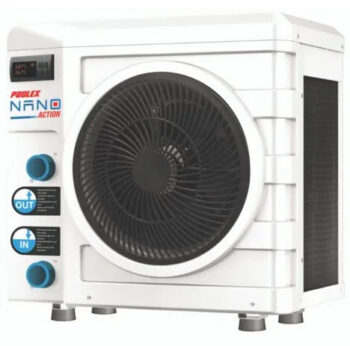
Ideal for small volumes, the Poolex Nano Action will seduce you with its affordable price. It shows a great performance and a remarkable versatility.
288 £ on ManomanoLooking to heat the water in your above-ground, tubular or in-ground pool? Choose the Poolex Nano Action. It is a heat pump specially designed for pools with a capacity of less than 21 m³. The heating temperature ranges from 15 °C to 40 °C. This pool heat pump therefore has an excellent coefficient of performance for a power of 3 kW. You will enjoy your pool throughout the season with a constant water temperature thanks to the Toshiba compressor.
The Poolex Nano Action also has a strong selling point, besides its low noise level: its price. It is offered at a fairly attractive price. By choosing this model, you will equip your above-ground pool with an efficient and energy-saving heat pump while making substantial savings.

This powerful and reliable heat pump is suitable for all types of pools under 40 m³. It remains functional, whatever the temperature, even the lowest.
1 519 £ on ManomanoNo matter what type of pool you have in your backyard, the Zodiac Power 7 will heat the water without difficulty. This heat pump is compatible with all pools with a capacity of less than 40 m³. It offers a flow rate of 4 m³/h and a coefficient of performance of 4.1. It is also particularly efficient in heating pool water while consuming little energy.
This coefficient of performance remains very high even at the lowest temperatures. The Zodiac Power 7 is equipped with a forced ventilation defrosting system. It will keep the pool water warm even when winter is in full swing. Thanks to its longevity, this equipment will accompany you for many years.
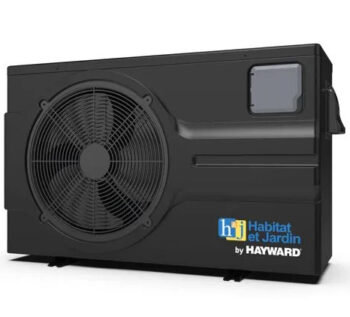
The Smart by Hayward Full Inverter is a reversible heat pump. It heats the water in the winter, but can also cool it during the warm seasons.
959 £ on ManomanoAny specific needs?
The best entry-level pool heat pump
A low-cost reversible heat pump
Your guide :
Rate this buying guide :By rating this buying guide, you are helping us to reward our best writers. Thank you!
| TOP OF THE LINE | CHEAP | TOP OF THE LINE | EXCELLENT | |

In accordance with our commitment, this buying guide does not contain any sponsored products. |
 9/10 |
 7/10 |
 8/10 |
 8/10 |
| OUR SELECTION |
ByPiscine Arroka Pro 90
|
Poolex Nano Action
|
Zodiac Power 7
|
Smart by Hayward Full Inverter
|
|
In any season, enjoy swimming in your pool by getting this connected model. It is easy to install and can be controlled from a smartphone.
|
Ideal for small volumes, the Poolex Nano Action will seduce you with its affordable price. It shows a great performance and a remarkable versatility.
|
This powerful and reliable heat pump is suitable for all types of pools under 40 m³. It remains functional, whatever the temperature, even the lowest.
|
The Smart by Hayward Full Inverter is a reversible heat pump. It heats the water in the winter, but can also cool it during the warm seasons.
|
|
|
Maximum recommended pool size
|
Up to 95 m³
|
Up to 21 m³
|
Up to 40 m³
|
Up to 25 m³
|
|
Maximum power input
|
12.5 kW
|
3 kW
|
7 kW
|
7.33 kW
|
|
Minimum operating temperature
|
-5 °C
|
8 °C
|
15 °C
|
-7 °C
|
|
Minimum noise level
|
34 dB
|
32 dB
|
38.7 dB
|
18 dB
|
|
Reversible
|
Yes
|
No
|
No
|
Yes
|
Help us improve this table:
Report an error, request the addition of a feature to the table, or suggest another product. Thank you for your kindness!
We spend thousands of hours each year studying the major specialized websites, analyzing products of hundreds of brands and reading user feedback to advise you on the best products.
We are a product review company with a single mission: to simplify your buying decisions. Our research and testing helps millions of people every year find the best products for their personal needs and budget.
To support us you can: use our links to make your purchases (which often earns us a small commission), share our articles on social networks, or recommend our site on your blog. Thanks in advance for your support!
This criterion indicates the heating capacity of the pool heat pump or PAC. The model you are interested in should have a power output equivalent to 15°C air temperature. A low-powered pool heat pump will operate for 1 week to bring the water to a temperature of between 15 and 28°C. Using 2 types of heating simultaneously allows you to quickly reach the desired temperature. For this purpose,do not hesitate to combine your pool heat pump with an electric heater. Inexpensive, it is an excellent complement. TheBestway Flowclear is a reference of its kind.
There are pool heat pumps for in-ground pools and others forabove-ground pools. Note that heat pumps are not necessarily interchangeable. Before any purchase, make sure the model you are interested in is suitable for the type of pool you have. If not, you will have bought expensive equipment for nothing. The size of the pool is directly related to the power and price of the pool heat pump. Manufacturers often indicate the volume of water that the heat pump can heat: 20, 30, 40, 80 or even more than 100 m³. Also consider the average air temperature in your area. You may need a powerful heat pump to heat a small pool of cold water.
Pool heat pumps use either a reciprocating compressor, a scroll compressor or a rotary compressor. In all cases, avoid the reciprocating compressor. Its lack of efficiency will make you disappointed and you will regret your purchase soon enough! Instead, opt for a scroll-type compressor, which is reputed to be the quietest of the three. And if you can afford it, get a heat pump with a 2-stage or rotary compressor. Such a pool heat pump is capable of delivering constant power, regardless of the source temperature.
Like any equipment with a compressor, the pool heat pump makes noise when it is running. This can be annoying in certain situations. But you will have to deal with it, instead of believing the false arguments of the PAC supposed to be silent, only to be disappointed. However, vertical heat pumps make less noise than horizontal ones.
Often
abbreviated COP, the coefficient of performancemeasures the efficiency of the pool heat pump at a given temperature. It is the thermal energy offered per electrical energy consumed. A pool heat pump with a COP of 3 produces 3 kWh of heating for 1 kWh of electricity consumed. If 2 heat pumps have the same power, the one with the highest COP is the best
, because it consumes less electricity. Therefore, the higher the COP, the more efficient the pool heat pump will be. Be aware, however, that a heat pump with a COP between 3 and 4 will perform up to expectations.
The heat pump is a slow heating system. Apart from the price, this is its major flaw. The water in the pool will not heat up instantly like the water in the shower. As mentioned above, it will take a few days to reach the desired temperature, especially if the pool is not covered when not in use. Before purchasing, determine how long you can tolerate the temperature rise. The shorter this time, the more powerful the heat pump will be and the more expensive it will be. Also consider the energy consumption of the pool heat pump. Stay within a reasonable range!
C'est la source d'alimentation de PAC la plus courante. Le gaz combine vitesse et puissance de chauffe. En général, les pompes à chaleur pour piscine au gaz naturel se raccordent à la ligne de votre compagnie de gaz ou à une bonbonne de propane. Le gaz est également bon marché, rendant cette option prisée par de nombreux propriétaires de piscines.
Les PAC à gaz maintiennent efficacement l'eau à température constante. Mais la quantité de gaz augmente considérablement dans les régions froides ou lors des saisons froides. Cependant, les modèles récents ont un allumage sans pilote, qui n'a pas à fonctionner en permanence. Ce qui fait économiser du gaz et donc de l'argent.
Une pompe à chaleur pour piscine électrique utilise le même principe que le chauffe-eau électrique. Elle utilise l'électricité pour chauffer un serpentin à l'intérieur de l'appareil, ce qui fera monter la température de l'eau. Ce processus est long. Comparée au modèle à gaz, une PAC électrique mettra plus de temps à chauffer l'eau de la piscine.
Il existe toutefois des PAC électriques capables de transférer la chaleur de l'air extérieur à l'eau de la piscine. Si vous habitez dans une région ensoleillée, cette option aura grand intérêt. De plus, le captage de l'air chaud requiert moins d'énergie que le gaz ou l'électricité standard tout en augmentant la durée de vie de la pompe. Mais cette installation coûte cher.
En termes d'investissement de départ, le solaire est l'option la plus chère. Mais une PAC fonctionnant à l'énergie solaire présente les coûts d'exploitation les plus bas sur le long terme. Une pompe à chaleur pour piscine solaire peut en effet durer 20 ans. Aucune pompe à chaleur électrique ou à gaz ne peut se vanter d'une durée de vie aussi longue !
À l'image du chauffe-eau solaire, la PAC solaire utilise des panneaux photovoltaïques pour capter la chaleur du soleil et chauffer l'eau de la piscine. L'inconvénient majeur est que le système ne peut fonctionner la nuit ni par temps nuageux. Mieux vaut faire appel à des professionnels pour ce type d'installation.
Si vous avez une grande piscine, une pompe à chaleur électrique est vivement conseillée. Bien qu'une PAC solaire soit assez coûteuse au départ, elle sera amortie dans les 7 ans, voire moins en fonction tarifs de gaz et d'électricité dans votre région. Enfin, privilégiez le gaz si vous n'avez pas besoin de chauffer votre piscine très souvent.
Pour faire simple, une PAC peut être considérée comme un climatiseur pour piscine. Quand l'eau est froide, elle la réchauffe. Et quand l'eau est trop chaude, elle peut la refroidir. Le fonctionnement se fait en circuit fermé, grâce à un fluide frigorigène, généralement du gaz R32, et différents composants comme le programmateur et le serpentin.
Cette information est fournie par le fabricant. Mais sachez qu'elle n'est pas tout à fait exacte. Si le fabricant affirme que la PAC fonctionne jusqu'à -10 °C, il ne se réfère pas à la température extérieure mais à celle mesurée au-dessus de l'évaporateur. Notez que la température de cette pièce descend sous 0 °C avec 5 °C de température dans l'air.
Le véritable intérêt de cette température minimale réside dans l'efficacité du système de dégivrage par inversion de cycle. Plus la température minimale annoncée par le fabricant est basse, plus le dégivrage sera rapide. Une information bonne à savoir si vous habitez une région connue pour ses températures fraîches.
Lorsque vous avez fini d'installer la PAC, réglez le débit d'eau grâce à la vanne centrale. Le bon réglage rendra la pompe efficiente. Une quantité d'eau supérieure à l'énergie produite ne permettra pas à la PAC de chauffer l'eau comme vous le souhaitez. En outre, un débit faible chauffera l'eau plus qu'il ne faut et vous fera gaspiller de l'énergie.
Le débit d'eau fait également varier les échanges de chaleur et la pression du fluide frigorigène. Ainsi, il augmente ou diminue en fonction de la température de l'eau. Adoptez des réglages bien spécifiques du débit d'eau pour la mise en service de la PAC, pendant la montée en température et une fois la température souhaitée atteinte.
Les pompes de chaleur pour piscine sont aussi équipées d'un programmateur. Ce dispositif aide à atteindre la bonne température de l'eau. Il informe à tout moment sur la température de l'eau et celle du bassin. Enfin, la minuterie permet de définir les horaires de fonctionnement de la PAC et ainsi optimiser la consommation d'énergie.
La formation de givre sur l'évaporateur, voire le gel de ce dernier, réduit les performances de la pompe à chaleur pour piscine. La solution courante pour les piscines extérieures est le dégivrage par ventilation ou dégivrage économique. Quelques minutes d'arrêt du circuit frigorifique suffisent pour le dégivrer naturellement.
Certaines PAC disposent d'un dégivrage par inversion de cycle ou dégivrage intensif. Ainsi, la pompe récupère la chaleur de l'eau dans la piscine et s'en sert pour dégivrer l'évaporateur. Les PAC équipées de ce système de dégivrage peuvent fonctionner jusqu'à -13 °C en toutes saisons, piscines intérieures et extérieures incluses.
Même la meilleure PAC du marché peut être optimisée. À titre d'exemple, installer un abri de piscine permet de maintenir l'eau du bassin à bonne température sans constamment recourir à la pompe. La pose d'une bâche ou couverture de piscine fera également l'affaire. En plus de ralentir la perte de chaleur, cette couverture thermique réduit le coût d'exploitation d'une PAC de plus de 50%, prévient l'évaporation, permet d'économiser des milliers de litres d'eau, et réduit la quantité de produits chimiques utilisés. Enfin, vous pouvez combiner la PAC et un réchauffeur électrique. Une fois la température atteinte, vous n'aurez qu'à couper le réchauffeur et programmer la pompe qui prendra le relais. Mais il faut bien calculer le coût énergétique entraîné par le réchauffeur électrique, même sur un bref délai.
Avant d'acheter une pompe à chaleur pour piscine, assurez-vous que le revêtement de votre bassin supporte des températures élevées. L'installation électrique doit aussi supporter la puissance de la PAC. N'hésitez pas à placer l'équipement à l'abri des intempéries, idéalement dans un local. Mais gardez-le à proximité de la piscine pour ne pas perdre de la chaleur dans la tuyauterie.
Lors de l'installation, vérifiez que la PAC n'est pas surélevée par rapport au filtre du bassin. Dans le cas contraire, l'eau ne sera pas correctement filtrée. L'installation d'un tuyau de récupération de la condensation de la PAC a également une grande importance. Tout comme l'installation d'un système by-pass permettant d'isoler la PAC pour la démonter si besoin.
Le montage d'une pompe à chaleur de piscine nécessite 2 raccordements. Le raccordement hydraulique entre la PAC et le bassin doit être parfaitement étanche et fermé. Il faut aussi procéder au raccordement électrique, c'est-à-dire, des câbles électriques permettant à la pompe de fonctionner, qu'elle soit électrique, solaire ou à gaz.
Le montage d'une pompe à chaleur de piscine est simple si vous avez un bon niveau en bricolage. Il faut notamment des connaissances solides en matière de câblage et raccordement électrique. Vous devrez également vous y connaître en plomberie pour installer le réseau hydraulique, sans oublier les connaissances de base concernant le fonctionnement d'une PAC.
Si vous ne disposez pas de ces compétences, souhaitez éviter les mauvaises manipulations ou n'avez ni temps ni volonté à y consacrer, faites appel à un professionnel. Dans de nombreux cas, cette option reviendra moins chère que s'entêter à installer la pompe soi-même et risquer de l'endommager ou même endommager la piscine.
Bon à savoir
Si le fabricant affirme que la PAC fonctionne jusqu'à -10 °C, il ne se réfère pas à la température extérieure mais à celle mesurée au-dessus de l'évaporateur.
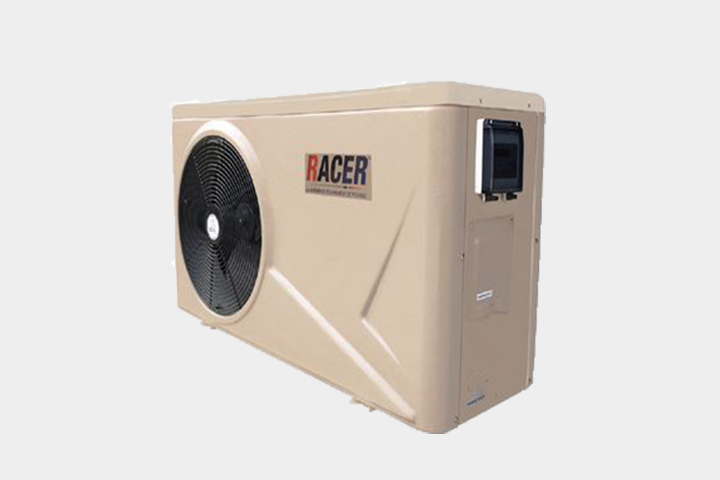
The horizontal heat pump is the most common model. It can be recognized by the fan on the front. The rectangular shape of the fan ensures a better distribution of the heat along the entire pool. This device is intended for a pool that is neither too large nor too small. For more precision, its power is suitable for a pool containing 50 to 70m3 of water. Its greatest advantage is its easy installation. The horizontal heat pump is installed on the ground. The cold air is released through a pipe behind the device.
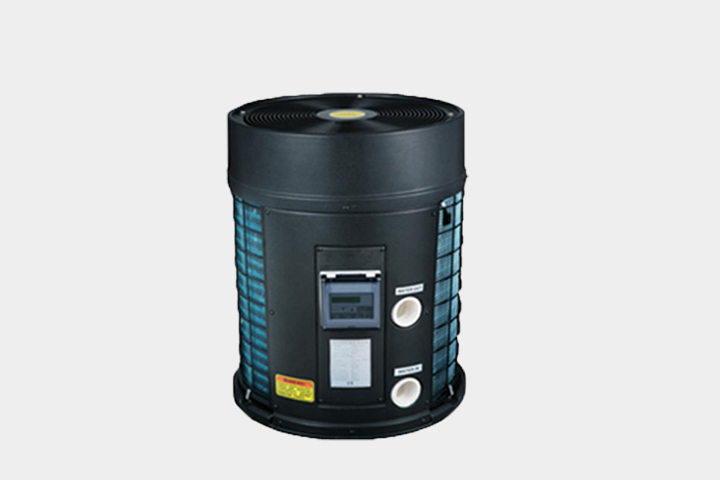
The vertical heat pump consumes more energy. It can go beyond 10,000 W. However, this has an advantageous counterpart for homeowners: a considerable heating capacity. It is less noisy than the first type of pool heat pump. As its name indicates, it is recognized by its vertical shape. It is less common than horizontal models. This device is nevertheless essential to have a good performance on large pools.
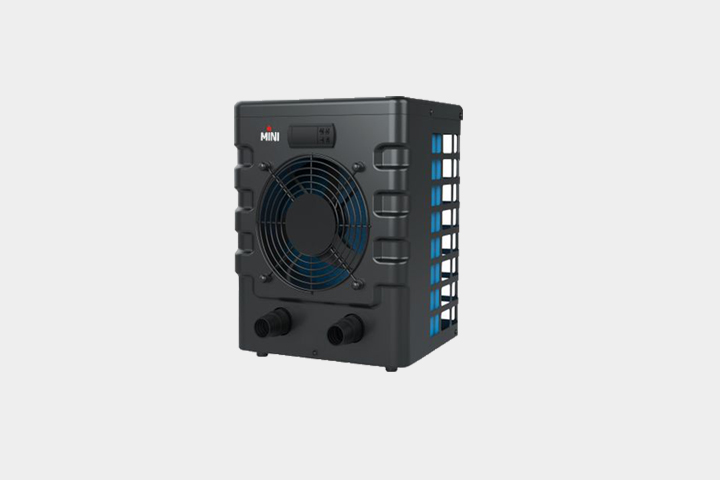
The mini pool heat pump is a compact device that is suitable for small pools and inflatable and above ground pools with a volume of about 10 to 20m3. It owes its performance to the power of its motor. The absorption power is estimated to be at least 500 W. As for the heating power, the lowest is 2,500 W. With this characteristic, the heating capacity is up to 2m3/h. Being a mini model, it is about 300 x 300 x 350 mm for a weight of about 10 kg.
A heat pump is particularly suitable for heating water in large pools. Despite the relatively high purchase price, it saves energy. In fact, it produces two to five times more energy than it consumes, because it draws heat from the outside air to release it. Thus, the investment is very quickly amortized! It should be noted, however, that some models do not work in regions where the outside temperature is often low, i.e. below 15°C.
A pool heater is an affordable solution at a very low price, but it is energy intensive. It takes up very little space and is easy to install, as you just have to put it on the filtration circuit to have heated water after a few hours. It is also an easy to maintain heating system. Unfortunately, with a heater, your electricity bill could go through the roof!
The pool heat pump is an expensive, but powerful, durable and reliable heating equipment. The purchase of a heat pump should be considered as an investment that will save you money in the medium and long term. A temperature coefficient of 3 or 4 generates reasonable operating costs. On the other hand, a pool heater is not very expensive to buy. But it consumes up to 7 times more electricity than a pool heat pump!
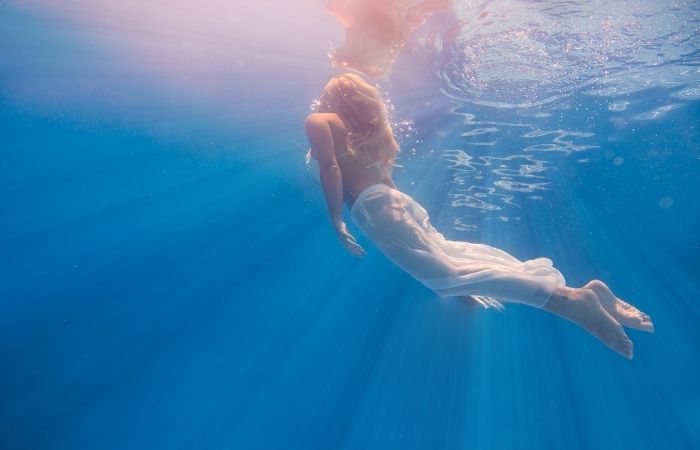
To heat your pool in a more ecological way
The heat pump is a practical and environmentally friendly alternative for heating a pool. All the elements of the device transform the calories of the air to allow the water of the pool to reach the right temperature quickly.
To save energy
Although more expensive to purchase, a heat pump is much more efficient than an electric heating system. It is an effective solution for heating water in large pools and saves electricity at the same time. A pool heat pump is more cost effective than other models available on the market.
To have a heated pool all year round
The pool heat pump is a very efficient device, no matter which range you choose. It allows you to maintain a certain temperature, regardless of the season. Note that the highest quality heat pumps can heat pools intended for competition.
To maintain good water hygiene
The heat pump is a completely self-contained device that works by drawing in natural air and then treating it and sending it into the pool to heat the water. But before reaching the pool, the air passes through several filters that remove all microbes, bacteria and impurities. As a result, the water in your pool will be completely clean.
For ease of use
It is an easy to install device. You just need to make a few settings like airflow and flow rate, and turn it on to do its job. The temperature of your pool will be managed in a more regular way. On the other hand, it is also a reliable device since a heat pump, regardless of its range, can run for several days without showing any signs of fatigue.
In our opinion, the best brands of heat pumps for swimming pools in 2022 are :
Poolstar offers many solutions for pool heating. These include the Jetline, Nano Turbo, Triline, Platinium and Silverline series. There is something for every size and type of pool. This brand is THE reference in terms of pool heat pumps.
Everyone knows the French brand for its famous inflatable boats. But did you know that Zodiac also manufactures pool cleaners, pool pumps and filters, not to mention its aerospace business? The brand's PACs are a guarantee of reliability and performance.
This brand is one of the most reliable on the market for swimming pool heat pumps. It also manufactures other equipment for pool water treatment. Its Pacfirst range is compatible with all sizes and types of pools.
A brand specialising in the manufacture of products for the garden and swimming pool, Edenéa offers a range of equipment at affordable prices. This reference brand of heat pumps does not neglect the quality of its products. On the contrary, it does not cease to manufacture tools that meet all the needs, and which are robust.
Gre makes everything your pool needs and more. Public pools, hotels and individuals will find the right PAC for them with this brand. It is a leading manufacturer of swimming pool kits and accessories.
The diagram below will help you to get an idea of the typical prices for each price range (entry-level, mid-range and high-end).
However, more expensive does not necessarily mean better.
We therefore advise you to always consult our ranking before deciding, rather than blindly relying on price ranges.
Pay attention to the dimensions of your heat pump
To ensure that the water temperature rises in an acceptable time and that energy consumption is reasonable, the size of your heat pump must be proportional to the size of your pool. If it is oversized, its consumption would be too high. If it is too small, it would take too long to heat up.
Place it in a suitable place
You should know that heat pumps make a lot of noise. For this reason, their installation must be carefully studied so as not to disturb your moment of relaxation by the pool.To do this, refer to the manufacturer's data indicating the noise level according to the distance. If not, consider a soundproofing system.
Think of the remote control
Some heat pump models can be controlled from a certain distance. That's because they have a control panel that can be kept at home or within easy reach. This is the perfect option for you if you plan to install your heat pump in a hard-to-reach corner, or if you want to be the only one to have control over it.
Maintain your heat pump properly
To ensure that your heat pump lasts as long as possible, it is recommended that you have it checked by a certified professional at least once a year. But there are also things you should do on a regular basis. For example, check the pressure level of your system and make sure that nothing is blocking the air vents. Also, de-ice the outside of your pump when necessary.
Protect it from temperature variations during the day
Heat pumps consume less electricity if you maintain the temperature at a constant level. Also, your bill will increase sharply if the temperature drops at night or when you are away. If you want to lower your consumption, reduce the temperature by as little as one degree.
To reduce the noise from the heat pump, you can use a noise barrier. Alternatively, cover the heat pump with a soundproofing box, which will also do the trick. If the pump is attached to the wall, place it on a concrete base with an average distance of 10 cm from the wall of the house.
There are two connections: a hydraulic connection and an electrical connection. For the first, the water passes through the filtration pump, then the tank, then the heat pump and finally the chlorine treatment unit. For the second, the electrical supply to the pump is connected to a differential circuit breaker. If necessary, call in a certified professional.
The swimming pool heat pump can be installed indoors in a closed and spacious room. But as a rule, it is installed outside, as it needs air as a resource. This will allow it to gain in performance. It should be no less than 3 m from the pool, but not more than 7 m either to avoid losing heat.
The swimming pool heat pump is activated when the water temperature reaches 10°. There are heat pumps that work with negative temperatures. If the filtration is working well, you just have to choose the desired temperature and the device does the rest of the work. The pump takes time to heat up the water so don't wait until the water is very cold before activating it.
The heat pump heats the pond water by 1° to 3°C per day. However, this also depends on the size of the pool and the volume of water to be heated. Air bubbles should form at the liquid sight glass. A gas leak, an unsuitable thermostat or a badly wired thermostat can prevent your heat pump from working properly.
Every month we help more than 1 000 000 people buy better and smarter.
Copyright © 2022 - Made with ♥ by buyingbetter.co.uk
Your reviews and buying guides 0% advertising, 100% independent!